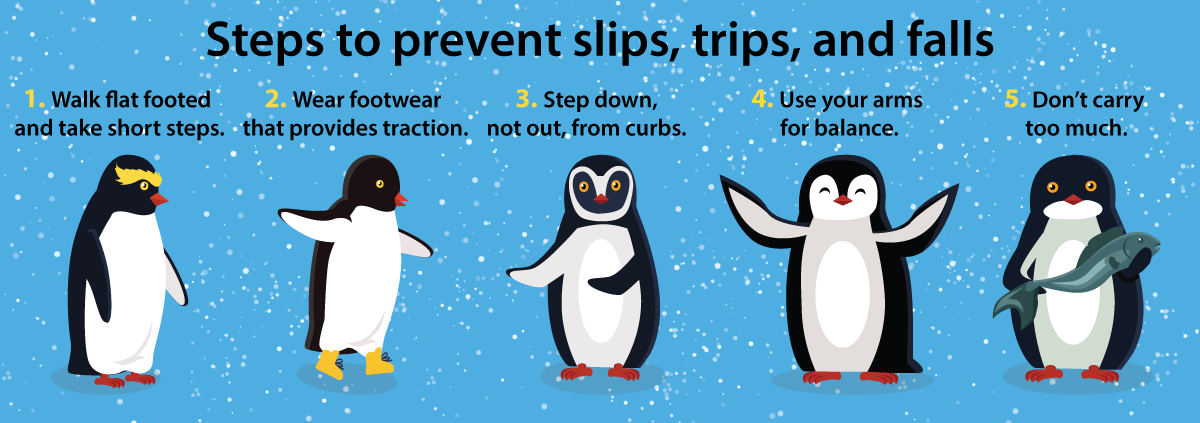
Slip and Fall Prevention
Changing seasons means changes in walking conditions. Slips and falls can cost cities and towns big in the form of workers’ compensation claims from employees or liability claims if the public slips and falls on municipal property. As a member-owner of these MMIA programs, cities and towns can work together to keep people safe and save money.
Slip and Fall Prevention Poster
To prevent slip and falls, cities/towns should:
- Establish a ground maintenance plan including snow removal.
- For snowfalls of less than four inches, brooms and other hand tools can be used to clear walkways.
- For snow accumulations of greater than four inches, mechanical means should be used for clearing snow.
- When ice cannot be promptly removed, sanding should be done in parking areas and walkways.
- Strategically place traction treatments such as sand, salt, or ice melt.
- Consider implementing “self-service” stations for traction treatments for staff to utilize as conditions change.
- Identify a location for the snow to be plowed and stored.
- Avoid stockpiling in areas where runoff would pose hazards for pedestrians.
- Ensure snow piles do not create an obstructed view to traffic.
- Keep fire protection equipment such as hydrants clear from obstruction.
- Maintain safe floors inside:
- Use strategically placed mats to prevent tracking of moisture and
- Have cleaning equipment and absorbent materials readily available for cleanup.
To avoid slip and falls, staff should:
- Take care exiting your vehicle or equipment.
- Slips and falls occur when exiting a vehicle because of surface changes, balance changes, uneven or slippery surfaces, and distractions.
- Keep three points of contact with the vehicle until you’re sure of solid footing. Scan the environment for hazards.
- Wear footwear appropriate for the conditions.
- Smooth-soles and high-heels (cowboy boots have both) do not provide good traction during fall and winter conditions in Montana.
- Wear non-slip or lug soled shoes or use traction devices on your footwear while walking outside.
- Plan your route.
- Use routes that are maintained regularly.
- Try to avoid long and steep walkways and stairways in wet or winter conditions when possible.
- Walk like a penguin when faced with snowy or slippery conditions.
- Fast long steps with fully extended legs makes you vulnerable to slips.
- Walk like a penguin to maximize stability. Lower your center of gravity by keeping knees bent and flexible. Point toes out slightly, keeping feet directly beneath you. Take small slow steps while keeping hands low and slightly out to the side. The worse the surface conditions, the more pronounced the penguin position.
- Go up and down stairs with caution.
- Stairways are common slip, trip, and fall areas and deserve extra attention.
- Always use the handrail while going up and down stairs.
- Avoid distractions such as using a cell phone or reading while walking on stairs.
- Check inside buildings to avoid common slip, trip, fall hazards.
- Curled rugs, spills, poor housekeeping, and other preventable conditions are common causes of injuries.
- Be diligent about housekeeping, carry small loads, properly place electrical cords, and use the correct equipment for the job.
- Notify your supervisor if:
- You are aware of any unsafe conditions. Conditions change quickly, and your input is key in timely addressing of hazards. Keep yourself, co-workers, and the public safe by notifying your supervisor of safety concerns; or
- You experience a slip, trip, or fall.